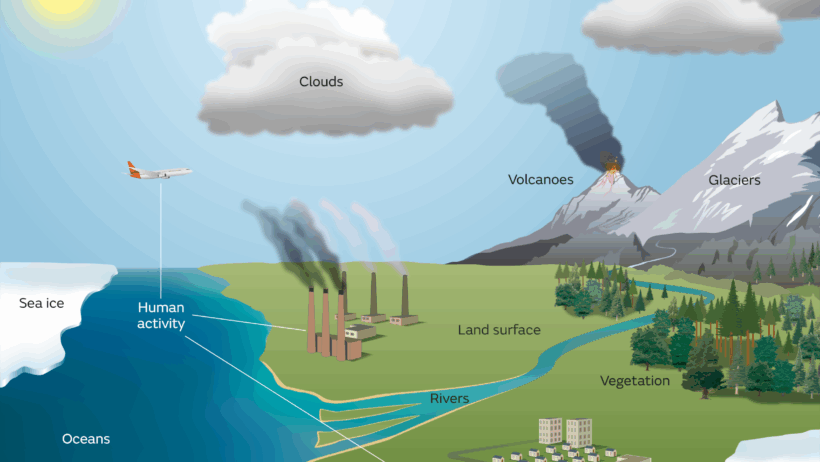Climate systems possess an intricate and marvelous ability to self-regulate, ensuring a degree of stability against the vast array of atmospheric conditions and perturbations they encounter. This remarkable ability, however, is not infinite; it can be disrupted, leading to consequences that could redefine our ecosystems and human life. Understanding the mechanisms behind climate self-correction provides insight into both the resilience of our planet and the vulnerabilities that threaten it. This article aims to elucidate the nuances of climate systems, the processes through which they self-correct, and the ramifications when these processes fail.
At the core of any discussion about climate self-correction is the concept of feedback loops. Feedback mechanisms can be either positive or negative. Negative feedback loops help to stabilize the system, counteracting changes when they occur. For example, when temperatures rise, increased evaporation can lead to cloud formation that reflects sunlight and cools the planet. Conversely, positive feedback loops can exacerbate conditions. A notable instance is the melting of polar ice, revealing darker ocean surfaces that absorb more solar radiation, thus accelerating warming. This duality creates a dynamic interplay that is crucial for maintaining climate equilibrium.
Consider, for instance, the carbon cycle. This fundamental system sees carbon exchanged between the atmosphere, oceans, and terrestrial ecosystems. Trees and plants sequester carbon dioxide (CO2) via photosynthesis, pulling it from the atmosphere and mitigating greenhouse gas concentrations. The oceans also act as carbon sinks, absorbing vast amounts of CO2 from the atmosphere. As such, healthy ecosystems contribute to climate stability. However, when these systems become compromised—through deforestation, ocean acidification, or pollution—the delicate balance is disrupted, thrusting the climate into turmoil.
Another vital aspect of climate systems is their inherent time delays. The lag in climate response can be both an ally and an adversary. For instance, the Earth’s climate may take years or even decades to fully react to a shift in greenhouse gas emissions. This delayed response can create a false sense of security; when emissions are reduced, temperatures may continue to rise for some time due to previous accumulation of heat in the oceans. Conversely, if emissions continue unchecked, the repercussions of climate change may materialize with alarming rapidity, as hidden feedback loops begin to amplify the effects.
One salient example of this self-corrective power is the natural variability seen in climate patterns. Seasonal changes, ocean currents, and atmospheric conditions work in concert to drive climate conditions toward a state of equilibrium. The El Niño and La Niña phenomena illustrate just how variable and interconnected climate systems can be. An El Niño event, characterized by warmer ocean temperatures in the central and eastern Pacific, can influence weather patterns globally, whereas La Niña brings cooler conditions and often counteracts the anomalies caused by its counterpart. These oscillations are essential for distributing heat around the globe and facilitate the self-correcting processes that maintain climate equilibrium.
However, this self-corrective capacity has limits. The monumental forces of anthropogenic climate change can overwhelm natural systems, leading to catastrophic tipping points. A prime example is the potential collapse of the Atlantic Meridional Overturning Circulation (AMOC), a critical component of the global climate system that helps regulate temperatures and weather patterns. If freshwater from melting Greenland ice disrupts this mechanism, the repercussions could be dire—not only would it alter regional climates, particularly in Europe, but it could also contribute to further destabilization of global weather systems.
Another critical tipping point is the permafrost thawing in Arctic regions. As permafrost thaws, it releases vast stores of methane, a potent greenhouse gas. This phenomenon represents a profound positive feedback loop that could magnify global warming. The implications are staggering; accelerated climate change may lead to more extreme weather, disruptions in agricultural output, and significant impacts on biodiversity. When the systems that have long functioned to mitigate change become sources of additional emissions, the very stability of our climate is called into question.
The urgency to understand these processes cannot be understated. Climate models have increasingly demonstrated that continued greenhouse gas emissions are likely to push the planet beyond these critical thresholds. The consequences are not merely theoretical; they manifest in increasingly severe weather events, rising sea levels, and alterations in ecosystems. These changes have significant implications for food security, water availability, and livelihoods around the globe, particularly for vulnerable populations.
Nevertheless, there is hope. Human innovation and technology can offer solutions to mitigate climate impacts. Renewable energy sources, such as solar, wind, and geothermal energy, provide avenues to reduce dependence on fossil fuels. Reforestation and sustainable land management can bolster natural carbon sinks, restoring some degree of balance to the carbon cycle. Furthermore, advancements in carbon capture technology hold promise for directly removing CO2 from the atmosphere, potentially alleviating some effects of climate change.
To shift our perspective on climate systems is to appreciate their complexity, resilience, and fragility. Understanding how these systems self-correct helps to underline the importance of taking proactive measures before reaching irreversible tipping points. As climate systems continue to respond to human actions, the imperative to foster sustainable practices and reduce greenhouse gas emissions becomes ever more pressing. The time is now to cultivate awareness and enact systemic change, embracing a future where humanity can coexist harmoniously with the natural world.



